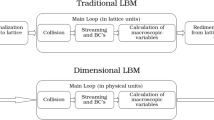A mathematical model of a thin vapor chamber is proposed. The model describes the processes of two-phase heat and mass transfer in this chamber on two spatial scales: the microscopic scale of a single cell of the capillary structure of the wick and the macroscopic scale of vapor chamber as a whole. Using the micromodel, the relationships used in a macromodel are obtained that link the local capillary pressure, wick permeability, and the evaporation flux density with the values of temperature, pressure, and degree of filling the wick with the working fluid. Such a multiscale approach was used for numerical study and optimization of the vapor chamber with a wick consisting of micropillars forming a regular hexagonal structure. A fundamental limitation on the width of the vapor core of the chamber is established, which is associated with an increase in the pressure of vapor during its flow in a narrow gap. The dependence of the thermal performance of the vapor chamber on the initial degree of filling the wick with the working fluid has been studied, and the importance of the precision filling of the chamber is shown. The proposed model can be extended by developing and introducing micromodels of new types of wicks, including those with a heterogeneous structure.
Similar content being viewed by others
References
1. C. Byon and S. J. Kim, The effect of meniscus on the permeability of micro-post arrays, J. Micromech. Microeng., 21, No. 11, Article ID 115011 (2011).
2. R. Ranjan, J. Y. Murthy, S. V. Garimella, and U. Vadakkan, A numerical model for transport in flat heat pipes considering wick microstructure effects, Int. J. Heat Mass Transf., 54, Nos. 1–3, 153–168 (2011).
3. K. A. Brakke, The surface evolver, Exp. Math., 1, No. 2, 141–165 (1992).
4. G. Huang, W. Liu, Y. Luo, and Y. Li, A novel ultra-thin vapor chamber for heat dissipation in ultra-thin portable electronic devices, Appl. Therm. Eng., 167, Article ID 114726 (2020).
5. Y. Yang, J. Li, H. Wang, D. Liao, and H. Qiu, Microstructured wettability pattern for enhancing thermal performance in an ultrathin vapor chamber, Case Studies Therm. Eng., 25, Article ID 100906 (2021).
Author information
Authors and Affiliations
Corresponding author
Additional information
Translated from Inzhenerno-Fizicheskii Zhurnal, Vol. 96, No. 7, pp. 1886–1895, November–December, 2023.
Rights and permissions
Springer Nature or its licensor (e.g. a society or other partner) holds exclusive rights to this article under a publishing agreement with the author(s) or other rightsholder(s); author self-archiving of the accepted manuscript version of this article is solely governed by the terms of such publishing agreement and applicable law.
About this article
Cite this article
Koznacheev, I.A., Malinovskii, A.I., Lyakh, M.Y. et al. Multiscale Mathematical Model of Heat and Mass Transfer in a Thin Vapor Chamber. J Eng Phys Thermophy 96, 1852–1861 (2023). https://doi.org/10.1007/s10891-023-02855-1
Received:
Published:
Issue Date:
DOI: https://doi.org/10.1007/s10891-023-02855-1




